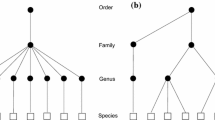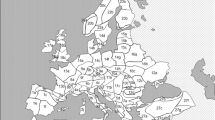Abstract
The ability to extrapolate from the known to the unknown is essential if we are to use the turnover of overall biodiversity, as opposed to a few well-known groups, to inform conservation planning. We investigated the usefulness of using evolutionary relationships of plants as a surrogate for the turnover of their associated beetle assemblages. If plant traits that are important to insects are phylogenetically conserved, it follows that there will be a positive relationship between insect faunal dissimilarity and plant evolutionary distance. We collected beetles using pyrethrum knock-down methods from 40 plant species belonging to four plant families in the Sydney region of Eastern Australia. We developed a novel approach for estimating variance in the dissimilarity of beetle assemblages, as explained by plant phylogeny, by using phylogenetic eigenvectors as explanatory variables in a distance-based redundancy analysis. We found a highly significant relationship between faunal dissimilarity and plant evolutionary distance for the entire beetle assemblage, the herbivorous component, and the non-herbivorous component, indicating that beetles generally showed some preference for particular plant clades as habitat, regardless of feeding guild. When comparing observed dissimilarities with those predicted from 40 jack-knife replicates of a Generalised Dissimilarity Model, we were often able to predict beetle turnover from plant phylogenetic relationships, although the reliability of this result was highly variable. Nevertheless, the broad response of beetle assemblages to plant evolutionary relatedness indicates real potential for plant phylogenetic pattern to act as a useful surrogate for insect biodiversity, especially when supplemented with other environmental correlates.




Similar content being viewed by others
Abbreviations
- AIC:
-
Akaike information criterion
- BLADJ:
-
Branch length adjustment
- GDM:
-
Generalised dissimilarity modelling
- PCoA:
-
Principal coordinates analysis
References
Anderson MJ, Gribble NA (1998) Partitioning the variation among spatial, temporal and environmental components in a multivariate data set. Aust J Ecol 23:158–167
Andrew NR, Hughes L (2004) Species diversity and structure of phytophagous beetle assemblages along a latitudinal gradient: predicting the potential impacts of climate change. Ecol Entomol 29:527–542
Australian Bureau of Meteorology (2010) Climate statistics for Australian locations. Australian Government. http://www.bom.gov.au/climate/data/. Accessed 16 Dec 2010
Barker NP, Weston PH, Rutschmann F et al (2007) Molecular dating of the ‘Gondwanan’ plant family Proteaceae is only partially congruent with the timing of the break-up of Gondwana. J Biogeogr 34:2012–2027
Basset Y (1996) Local communities of arboreal herbivores in Papua New Guinea: predictors of insect variables. Ecology 77:1906–1919
Basset Y, Novotny V, Miller SE et al (2004) Conservation and biological monitoring of tropical forests: the role of parataxonomists. J Appl Ecol 41:163–174
Bininda-Emonds ORP (2004) The evolution of supertrees. Trends Ecol Evol 19:315–322
Brooker MIH (2000) A new classification of the genus Eucalyptus. Aust Syst Bot 13:79–148
Campos RI, Vasconcelos HL, Ribeiro SP et al (2006) Relationship between tree size and insect assemblages associated with Anadenanthera macrocarpa. Ecography 29:442–450
Carver M, Gross GF, Woodward TE (1991) Hemiptera. In: Naumann ID, Carne PB, Lawrence JF et al (eds) The insects of Australia volume i. Melbourne University Press, Melbourne
Chapman AD (2009) Numbers of living species in Australia and the World 2nd edn. Australian Biological Resources Study, Canberra
Chase MW, Morton CM, Kallunki JA (1999) Phylogenetic relationships of Rutaceae: a cladistic analysis of the subfamilies using evidence from rbcL and atpB sequence variation. Am J Bot 86:1191–1199
Crayn DM, Quinn CJ (2000) The evolution of the atpb-rbcL intergenic spacer in the Epacrids (Ericales) and its systematic and evolutionary implications. Mol Phylogenet Evol 16:238–252
Crisp M, Cook LG, Steane DA (2004) Radiation of the Australian flora: what can comparisons of molecular phylogenies across multiple taxa tell us about the evolution of diversity in present-day communities? Philos Trans R Soc Lond B Biol Sci 359:1551–1571
Crozier RH, Dunnett AgapowPM (2005) Phylogenetic biodiversity assessment based on systematic nomenclature. Evolutionary Bioinformatics 1:11–36
Davies TJ, Barraclough TG, Chase MW et al (2004) Darwin’s abominable mystery: insights from a supertree of the angiosperms. Proc Natl Acad Sci U S A 101:1904–1909
Diniz-Filho JAF, De Sant’ana CER, Bini LM (1998) An eigenvector method for estimating phylogenetic inertia. Evolution 52:1247–1262
Diniz-Filho JAF, De Marco Jr P, Hawkins BA (2010) Defying the curse of ignorance: perspectives in insect macroecology and conservation biogeography. Insect Conserv Diver 3:172–179
Faith DP, Walker PA (1996) Environmental diversity: on the best-possible use of surrogate data for assessing the relative biodiversity of sets of areas. Biodivers Conserv 5:399–415
Faith DP, Ferrier S, Walker PA (2004) The ED strategy: how species-level surrogates indicate general biodiversity patterns through an ‘environmental diversity’ perspective. J Biogeogr 31:1207–1217
Ferrier S, Manion G (2007) GDM R Distribution Pack version 1.1. http://www.biomaps.net.au/gdm/. Accessed 16 Dec 2010
Ferrier S, Manion G, Elith J et al (2007) Using generalized dissimilarity modelling to analyse and predict patterns of beta diversity in regional biodiversity assessment. Divers Distrib 13:252–264
Frenzel M, Brandl R (2001) Hosts as habitats: faunal similarity of phytophagous insects between host plants. Ecol Entomol 26:594–601
Hamilton AJ, Basset Y, Benke KK et al (2010) Quantifying uncertainty in estimation of tropical arthropod species richness. Am Nat 176:90–95
Jones C, Lawton J (1991) Plant chemistry and insect species richness of British Umbellifers. J Anim Ecol 60:767–777
Jordan GJ, Hill RS (1996) The fossil record of the Epacridaceae. Ann Bot 77:341–346
Jurado-Rivera JA, Vogler AP, Reid CAM et al (2008) DNA barcoding insect–host plant associations. Proc R Soc Lond B Biol Sci 276:639–648
Kennedy CEJ, Southwood TRE (1984) The number of species of insects associated with British trees: a re-analysis. J Anim Ecol 53:455–478
Kitching RL, Hurley KL, Thalib L et al (2003) Tree relatedness and the similarity of insect assemblages: pushing the limits? In: Basset Y, Kitching RL, Miller S et al (eds) Arthropods of tropical forests: spatio-temporal dynamics and resource use in the canopy. Cambridge University Press, Cambridge
Lawrence JF, Britton EB (1991) Coleoptera. In: Naumann ID, Carne PB, Lawrence JF et al (eds) The insects of Australia volume II. Melbourne University Press, Melbourne
Legendre P, Anderson MJ (1999) Distance-based redundancy analysis: testing multispecies responses in multifactorial ecological experiments. Ecol Monogr 69:1–24
Legendre P, Durand S (2010) rdaTest: R library to compute simple and partial canonical redundancy analysis (RDA) with permutation test. http://www.bio.umontreal.ca/legendre/indexEn.html. Accessed 16 Dec 2010
Legendre P, Legendre L (1998) Numerical ecology. Elsevier, Amsterdam
Legendre P, Borcard D, Peres-Neto PR (2008) Analyzing or explaining beta diversity? comment. Ecology 89:3238–3244
Major RE, Christie FJ, Gowing G et al (2003) The effect of habitat configuration on arboreal insects in fragmented woodlands of south-eastern Australia. Biol Conserv 113:35–48
Mast AR, Givnish T (2002) Historical biogeography and the origin of stomatal distributions in Banksia and Dryandra (Proteaceae) based on their cpDNA phylogeny. Am J Bot 89:1311–1323
Moir ML, Brennan KEC, Majer JD et al (2005) Toward an optimal sampling protocol for Hemiptera on understorey plants. J Insect Conserv 9:3–20
Moir ML, Brennan KEC, Majer JD et al (2010) Plant species redundancy and the restoration of fauna habitat: lessons from plant-dwelling bugs. Rest Ecol 18:136–147
Nipperess DA, Faith DP, Barton K (2010) Resemblance in phylogenetic diversity among ecological samples. J Veg Sci 21:809–820
Novotny V, Basset Y, Miller SE et al (2002) Low host specificity of herbivorous insects in a tropical forest. Nature 416:841–844
Novotny V, Drozd P, Miller SE et al (2006) Why are there so many species of herbivorous insects in tropical rainforests? Science 313:1115–1118
Ødegaard F (2006) Host specificity, alpha- and beta-diversity of phytophagous beetles in two tropical forests in Panama. Biodivers Conserv 15:83–105
Ødegaard F, Diserud OH, Ostbye K (2005) The importance of plant relatedness for host utilization among phytophagous insects. Ecol Lett 8:612–617
Ohmart CP, Edwards PB (1991) Insect herbivory on Eucalyptus. Annu Rev Entomol 36:637–657
Oksanen J, Kindt R, Legendre P et al. (2008) vegan: Community Ecology Package. R package version 1.15-0
Oliver I, Beattie AJ (1993) A possible method for the rapid assessment of biodiversity. Conserv Biol 7:562–568
Orchard AE (1999) Introduction. In: Orchard AE (ed) Flora of Australia volume 1–introduction, 2nd edn edn. CSIRO Publishing, Collingwood
Orians GH, Milewski AV (2007) Ecology of Australia: the effects of nutrient-poor soils and intense fires. Biol Rev 82:393–423
Pfeil BE, Crisp MD (2008) The age and biogeography of Citrus and the orange subfamily (Rutaceae: Aurantioideae) in Australasia and New Caledonia. Am J Bot 95:1621–1631
Proches S, Forest F, Veldtman R et al (2009) Dissecting the plant-insect diversity relationship in the Cape. Mol Phylogenet Evol 51:94–99
Quinn CJ, Crayn DM, Heslewood M et al (2003) A molecular estimate of the phylogeny of Styphelieae (Ericaceae). Aust Syst Bot 16:581–594
R Development Core Team 2008 R: A Language and Environment for Statistical Computing. R Foundation for Statistical Computing. http://www.r-project.org/. Accessed 17 Dec 2010
Reid CAM (2006) A taxonomic revision of the Australian Chrysomelinae, with a key to the genera (Coleoptera : Chrysomelidae). Zootaxa 1292:1–119
Robinson L (2003) Field guide to the native plants of Sydney. Kangaroo Press, Kenthurst
Slipinski SA (2007) Australian ladybird beetles (Coleoptera: Coccinellidae): their biology and classification. Australian Biological Resources Study, Canberra
Stork NE (1987) Guild structure of arthropods from Bornean rain forest trees. Ecol Entomol 12:69–80
Strong DR, Lawton JH, Southwood SR (1984) Insects on plants. Harvard University Press, Cambridge
Taylor GS, Moir ML (2009) In threat of co-extinction: two new species of Acizzia Heslop-Harrison (Hempitera: Psyllidae) from vulnerable species of Acacia and Pultenaea. Zootaxa 2249:20–32
Udovicic F, Ladiges PY (2000) Informativeness of nuclear and chloroplast DNA regions and the phylogeny of the eucalypts and related genera (Myrtaceae). Kew Bull 55:633–645
Webb CO (2000) Exploring the phylogenetic structure of ecological communities: an example for rain forest trees. Am Natur 156:145–155
Webb CO, Ackerly DD, Kembel SW (2008) Phylocom: software for the analysis of phylogenetic community structure and trait evolution. Version 4.0. http://www.phylodiversity.net/phylocom/. Accessed 17 Dec 2010
Weiblen GD, Webb CO, Novotny V et al (2006) Phylogenetic dispersion of host use in a tropical insect herbivore community. Ecology 87:S62–S75
Weston PH, Barker NP (2006) A new suprageneric classification of the Proteaceae, with an annotated checklist of genera. Telopea 11:314–344
Weston PH, Carolin RC, Armstrong JA (1984) A cladistic analysis of Boronia Sm. and Boronella Baill. (Rutaceae). Aust J Bot 32:187–203
Wilson PG, O’Brien MM, Heslewood M et al (2005) Relationships within Myrtaceae sensu lato based on a matK phylogeny. Plant Syst Evol 251:3–19
Acknowledgments
We thank B. Bowman (Macquarie University) for assistance in collecting and sorting specimens. P. Wilson (Macquarie University), R. Colwell (University of Connecticut) and A. Ives (University of Wisconsin) provided valuable advice. N. Stork and eight anonymous reviewers provided comments and suggested revisions for this manuscript. This project was funded from a grant (DP0665761) awarded to L. Hughes, A. Beattie, D. Faith and R. Kitching by the Australian Research Council, Commonwealth of Australia.
Author information
Authors and Affiliations
Corresponding author
Rights and permissions
About this article
Cite this article
Nipperess, D.A., Beattie, A.J., Faith, D.P. et al. Plant phylogeny as a surrogate for turnover in beetle assemblages. Biodivers Conserv 21, 323–342 (2012). https://doi.org/10.1007/s10531-011-0185-y
Received:
Accepted:
Published:
Issue Date:
DOI: https://doi.org/10.1007/s10531-011-0185-y




